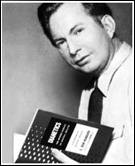A Natural Understanding of the Mind

THE PARTS OF THE MIND
L. Ron Hubbard discovered that the mind has two very distinct parts. One of these — that part which one consciously uses and is aware of — is called the analytical mind. This is the portion of the mind which thinks, observes data, remembers it and resolves problems. It has standard memory banks which contain mental image pictures, and uses the data in these banks to make decisions that promote survival.
However, two things appear to be — but are not — recorded in the standard banks: painful emotion and physical pain. In moments of intense pain, the action of the analytical mind is suspended and the second part of the mind, the reactive mind, takes over.

When a person is fully conscious, his analytical mind is fully in command. When the individual is “unconscious” in full or in part, the reactive mind cuts in, in full or in part. “Unconsciousness” could be caused by the shock of an accident, anesthetic used for an operation, the pain of an injury or the deliriums of illness.
When a person is “unconscious,” the reactive mind exactly records all the perceptions of that incident, including what happens or is said around the person. It also records all pain and stores this mental image picture in its own banks, unavailable to the individual’s conscious recall and not under his direct control. Though it may appear that a person knocked out in an accident is unconscious and unaware of happenings around him, his reactive mind is actually industriously recording everything for future use.
The reactive mind does not store memories as we know them. It stores particular types of mental image pictures called engrams. These engrams are a complete recording, down to the last accurate detail, of every perception present in a moment of partial or full “unconsciousness.”
This is an example of an engram: A woman is knocked down by a blow to the face. She is rendered “unconscious.” She is kicked in the side and told she is a faker, that she is no good, that she is always changing her mind. A chair is overturned in the process. A faucet is running in the kitchen. A car is passing in the street outside.
The engram contains a running record of all these perceptions.
The problem with the reactive mind is that it “thinks” in identities, one thing identical to another. The equation is A=A=A=A=A. A reactive mind computation about this engram would be: the pain of the kick equals the pain of the blow equals the overturning chair equals the passing car equals the faucet equals the fact that she is a faker equals the fact that she is no good equals the fact that she changes her mind equals the voice tones of the man who hit her equals the emotion equals a faker equals a faucet running equals the pain of the kick equals organic sensation in the area of the kick equals the overturning chair equals changing one’s mind equals . . . But why continue? Every single perception in this engram equals every other perception in this engram.
In the future, when this woman’s present environment contains enough similarities to the elements found in the engram, she will experience a reactivation of the engram. For example, if one evening the faucet were running and she heard the sound of a car passing outside and, at the same time her husband (the man in her engram) was scolding her about something in a similar tone of voice as used in the original engram, she could experience a pain in the side (where she was kicked earlier).
And the words spoken in the engram could also become commands in the present: She might feel that she was no good, or get the idea that she was always changing her mind. The reactive mind is telling the woman that she is in dangerous quarters. If she stays, the pain in the areas where she was abused could become a predisposition to illness or a chronic illness in themselves. This phenomenon of “awakening” the old engram is called restimulation.
The reactive mind is not an aid to a person’s survival for the excellent reason that though it is sturdy enough to hold up during pain and “unconsciousness,” it is not very intelligent. Its attempts to “prevent a person from getting himself into danger,” by enforcing its engram content, can cause unevaluated, unknowing and unwanted fears, emotions, pains and psychosomatic illnesses that one would be much better off without.
More on Dianetics
Here is also a set of DVDs to also help you quickly understand the concept of the book. https://www.myreligion-canberra-dmsmh.com.au/2019/10/03/dianetics-dvd-2/
There are other Books from Dianetics and Scientology Canberra.
There is also Dianetics: The Modern Science of Mental Health, Dianetics: Evolution of a Science, Dianetics: The Original Thesis.
And there are lectures of Dianetics that were recorded over seventy years ago.
And here is more information about the author, L. Ron Hubbard. https://www.myreligion-canberra-lrh.com.au/